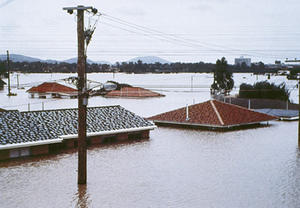DisastersBrisbane under water
Brisbane, a city of two million and Australia’s third largest, is flooded; roads are inundated, railway lines have been cut, and sewage is spreading into the waters; dozens of suburbs are under three meters of waters, with some factories and homes only visible by their roofs; more than 100,000 properties had their power cut as a precaution against flooding of electricity substations; the worst affected area was the town of Toowoomba, west of Brisbane, where residents described an 8-meter “instant inland tsunami” ripping through the streets on Monday; the flood zone in northern Australia now covers are larger than Germany and France combined

If not for the roofs, no buildings would be seen // Source: ema.gov.au
Australia’s third largest city, Brisbane, has woken to widespread flooding, although the peak level is a meter lower than feared, officials say.
The Brisbane River peaked at 4.46 meter (14.6ft) just before 05:30 (19:30GMT Wednesday), compared with 5.4 meter (17.7ft) in the 1974 floods.
Dozens of suburbs and thousands of properties are inundated.
The death toll in Queensland’s flooding stands at thirteen so far, with dozens more reported missing. Although the flood level in Brisbane was lower than feared, Queensland premier Anna Bligh said: “This is still a very dangerous situation and we have thousands of people who are waking this morning to the total devastation of either their homes, businesses — for some people it’s both. We should be very mindful that Mother Nature has done shocking and devastating damage. People are living, at the moment, in what I would call a post-war zone.”
Bligh had warned that many of the people of Brisbane would wake to scenes they had never seen before.
Roads are inundated, railway lines have been cut, and sewage is spreading into the waters.
The suburb of Rocklea is under three meters of water, the Brisbane Courier Mail reported, with some factories and homes only visible by their roofs.
The water levels will be high during Thursday but are not expected to exceed 4.6 meters. The levels will only slowly recede over the weekend.
The BBC reports that one reason for a reduced peak was that the Wivenhoe and Somerset dams had reduced the amount of water they were being forced to release to ease pressure.
Brisbane airport survived the swell and remains open, with almost all flights unaffected. Passengers are advised to check before travel. Public transport to the airport is severely limited.
Brisbane’s Gateway Bridges were closed and reopened twice overnight amid fears that floating debris could cause damage.
One huge concern was a 300 meter-long chunk of a concrete river walkway that sheared loose and sped down the Brisbane river.
One resident, Suzy Wilson, told the BBC: “It’s just an enormous structure, it’s very long, it was broken up in a couple of places, it’s simply extraordinary to see it come past.”
Water police managed to escort it away from damaging any bridges.
Wednesday had seen boats and pontoons floating down the river, along with massive amounts of other debris.
Brisbane Lord Mayor Campbell Newman said he had “a sense of horror and awe about the power of the river.”
“At the moment we are seeing pontoons and people’s boats… sadly in the coming hours we might be seeing bits of people’s houses… and that breaks my heart.”
The city’s West End, Taringa, and Indooropilly districts have been badly hit.
Many supermarkets in the city have been stripped of supplies, while a number of rubbish collections and bus services have halted.
A boat swept down the swollen Brisbane river sinks after hitting a bridge
More than 100,000 properties had their power cut as a precaution against flooding of electricity substations.
West of Brisbane in the city of Ipswich, the Bremer river peaked at 19.4 meters on Wednesday, the Bureau of Meteorology reported.
About 1,000 homes were inundated and 7,500 more affected, the Queensland Times reported.
More than 1,000 people are in evacuation centers there.
Ipswich Mayor Paul Pisasale said he expected flood levels to drop within the next thirty-six hours, allowing the clean-up to begin afterwards.
“If I find anybody looting in our city, they will be used as flood markers,” he warned.
One man found dead in his car in Ipswich has not yet been included in the death toll of twelve.
Bligh said: “There are some parts of Brisbane and Ipswich which are already completely unrecognizable.”
She vowed the state would get back on its feet swiftly. “We believe we can recover very quickly. That is our intention,” she said.
Gillard urged Australians to look out for their neighbors. “If there’s someone in your street you’re worried about, maybe an older Australian that you haven’t seen for a while, maybe give them a knock on the door and make sure they’re okay.”
The worst affected area was the town of Toowoomba, west of Brisbane, where residents described an 8-meter “instant inland tsunami” ripping through the streets on Monday.
One good piece of news on Wednesday was that the number of missing in the Lockyer Valley had been revised down from 51 to 43, but there were grave fears for nine.
Though the full extent of the damage will not be known until the water is gone, even before Brisbane was threatened, Queensland premier Bligh estimated a cleanup and rebuilding to total around $5 billion.
Add to that the damage to economy: Queensland’s coal industry has virtually shut down, costing millions in deferred exports and sending global prices higher. Vegetables, fruit and sugarcane crops in the rich agricultural region have been wiped out, and prices are due to skyrocket as a result.
